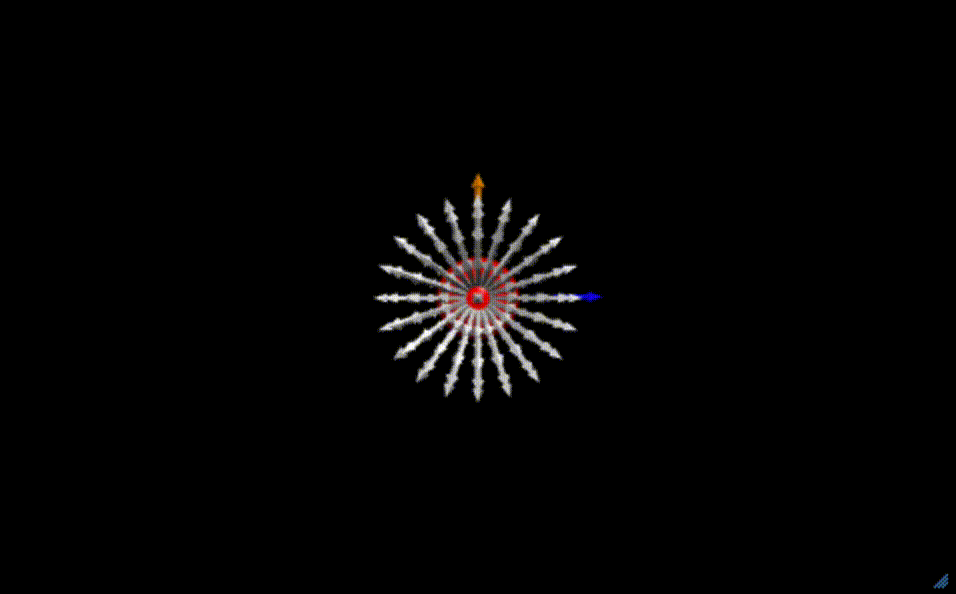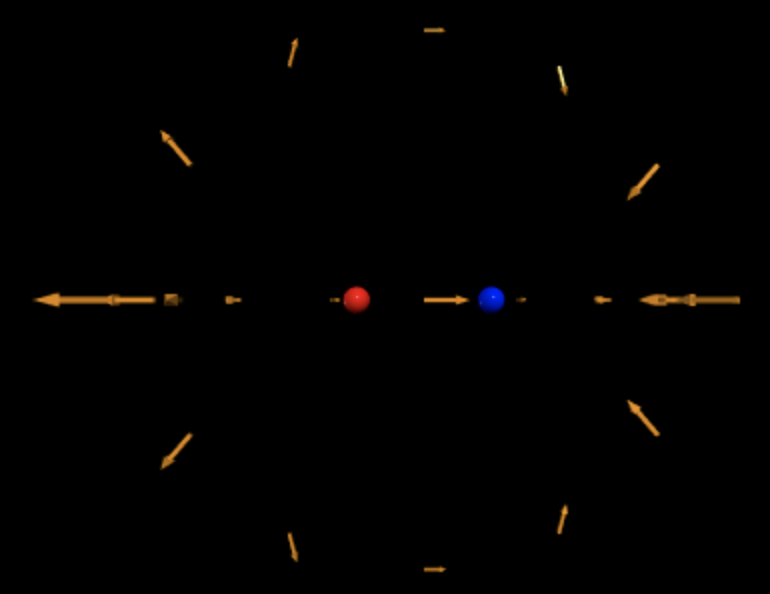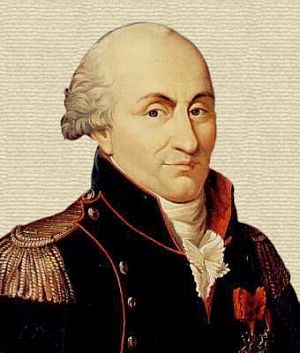Point Charge
This page is all about the Electric Field due to a Point Charge.CLAIMED BY JENNIFER YU 09/06/19 (Fall 2019)
The Main Idea
(Ch 13.1 in Matter & Interactions Vol. 2: Modern Mechanics, 4th Edition by R. Chabay & B. Sherwood)
Point Charge/Particle - an object with a radius that is very small compared to the distance between it and any other objects of interest in the system. Since it is very small, the object can be treated as if all of its charge and mass are concentrated at a single "point".
- Electrons and Protons are always considered to be point particles unless stated otherwise
2 types of point charges:
- Protons (e) --> positive point charges, ( q = 1.6e-19 Coulombs)
- Electrons (-e) --> negative point charges, (q = -1.6e-19 Coulombs)
Like point charges attract, opposite point charges repel.
ex.
| Point Charges | Result | Diagram |
|---|---|---|
| 1 proton, 1 electron | Attract | 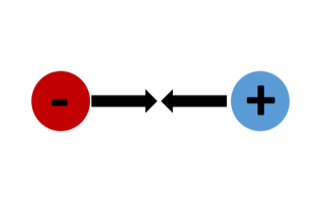 |
| 2 protons | Repel | 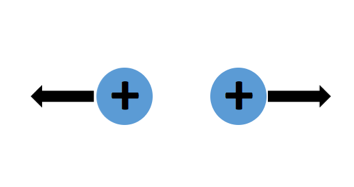 |
| 2 electrons | Repel | 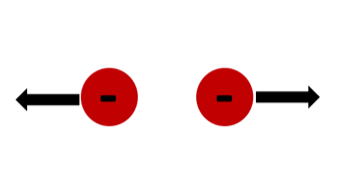 |
The Electric Field
(Ch 13.3 in Matter & Interactions Vol. 2: Modern Mechanics, 4th Edition by R. Chabay & B. Sherwood)
The electric field created by a charge is present throughout space at all times, whether or not there is another charge around to feel its effects.
Electric Field of a Charge Observed at a location: F = Eq
- F = Force on particle 2
- E = electric field at source location
- q = charge of particle 2
The magnitude of the electric field decreases with increasing distance from the point charge.
| The electric field of a positive point charge points radially outward | The electric field of a negative point charge points radially inward |
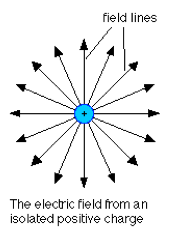 |
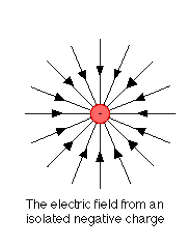 |
A Mathematical Model
Electric Field due to Point Charge
(Ch 13.4 in Matter & Interactions Vol. 2: Modern Mechanics, 4th Edition by R. Chabay & B. Sherwood)
Electric Field of a Point Charge ([math]\displaystyle{ \vec E }[/math]):
[math]\displaystyle{ \vec E=\frac{1}{4 \pi \epsilon_0 } \frac{q}{\mid\vec r\mid ^2} \hat r }[/math] (Newtons/Coulomb)
- [math]\displaystyle{ \frac{1}{4 \pi \epsilon_0 } }[/math] is Coulomb's Constant and is approximately [math]\displaystyle{ 8.987*10^{9}\frac{N m^2}{C^2} }[/math]
- q is the charge of the particle
- r is the magnitude of the distance between the observation location and the source location
- [math]\displaystyle{ \hat r }[/math] is the unit vector in the direction of the distance from the source location to the observation point.
The direction of the electric field at the observation location depends on the both the direction of [math]\displaystyle{ \hat r }[/math] and the sign of the source charge.
- If the source charge is positive, the field points away from the source charge.
- If the source charge is negative, the field points toward the source charge.
Coulomb Force Law for Point Charges
(Ch 13.2 in Matter & Interactions Vol. 2: Modern Mechanics, 4th Edition by R. Chabay & B. Sherwood)
[math]\displaystyle{ \mid\vec F\mid=\frac{1}{4 \pi \epsilon_0 } \frac{\mid Q_1Q_2 \mid}{r^2} }[/math]
Coulomb's law is one of the four fundamental physical interactions, and it describes the magnitude of the electric force between two point-charges.
[math]\displaystyle{ Q_1, Q_2 }[/math]= The charge of two particles of interest
- [math]\displaystyle{ \mid\vec F\mid=\frac{1}{4 \pi \epsilon_0 } }[/math] = constant,
- [math]\displaystyle{ Q_1, Q_2 }[/math] = the magnitudes of the point charges
- r = The distance between the two particles
Connection Between Electric Field and Force
The force on a source charge is determined by [math]\displaystyle{ F = Eq }[/math] where E is the electric field and q is the charge of a test charge in Coulombs.
By solving for the electric field in [math]\displaystyle{ F = Eq }[/math], with F modeled by Coulomb's Law, you get the equation for the electric field of the point charge:
[math]\displaystyle{ E = \frac{F}{q_2} = \frac{1}{4 \pi \epsilon_0 } \frac{q_1q_2}{r^2}\frac{1}{q_2}\hat r = \frac{1}{4 \pi \epsilon_0 } \frac{q_1}{r^2} \hat r }[/math]
A Computational Model
Below is a link to a code which can help visualize the Electric Field at various observation locations due to a proton. Notice how the arrows decrease in size by a factor of [math]\displaystyle{ \frac{1}{r^{2}} }[/math] as the observation location gets farther from the proton. The magnitude of the electric field decreases as the distance to the observation location increases.
Two adjacent point charges of opposite sign exhibit an electric field pattern that is characteristic of a dipole. This interaction is displayed in the code below. Notice how the electric field points towards the negatively charged point charge (blue) and away from the positively charged point charge (red).
Examples
Simple
There is an electron at the origin. Calculate the electric field at <4, -3, 1> m.
| Step 1. Find [math]\displaystyle{ \hat r }[/math]
Find [math]\displaystyle{ \vec r_{obs} - \vec r_{electron}: ((4,-3,1) - (0,0,0) = \lt 4,-3,1\gt }[/math]m. Calculate the magnitude of [math]\displaystyle{ \vec r }[/math]: ([math]\displaystyle{ \sqrt{4^2+(-3)^2+1^2}=\sqrt{26} }[/math] From [math]\displaystyle{ \vec r }[/math], find the unit vector [math]\displaystyle{ \hat{r}. }[/math] [math]\displaystyle{ \lt \frac{4}{\sqrt{26}},\frac{-3}{\sqrt{26}},\frac{1}{\sqrt{26}}\gt }[/math] | |
| Step 2: Find the magnitude of the Electric Field [math]\displaystyle{ E_{mag}= \frac{1}{4 \pi \epsilon_0 } \frac{q}{r^2} = \frac{1}{4 \pi \epsilon_0 } \frac{-1.6 * 10^{-19}}{26} }[/math] | |
| Step 3: Multiply the magnitude of the Electric Field by [math]\displaystyle{ \hat{r} }[/math] to find the Electric Field [math]\displaystyle{ E = \frac{1}{4 \pi \epsilon_0 } \frac{-1.6 * 10^{-19}}{26}*\lt \frac{4}{\sqrt{26}},\frac{-3}{\sqrt{26}},\frac{1}{\sqrt{26}}\gt = \lt -4.34*10^{-11},3.26*10^{-11},-1.09*10^{-11}\gt N/C }[/math] |
Middling
A particle of unknown charge is located at (-0.21, 0.02, 0.11) m. Its electric field at point (-0.02, 0.31, 0.28) m is [math]\displaystyle{ \lt 0.124, 0.188, 0.109\gt }[/math] N/C. Find the magnitude and sign of the particle's charge.
Given both an observation location and a source location, one can find both r and [math]\displaystyle{ \hat{r} }[/math] Given the value of the electric field, one can also find the magnitude of the electric field. Then, using the equation for the magnitude of electric field of a point charge,[math]\displaystyle{ E_{mag}= \frac{1}{4 \pi \epsilon_0 } \frac{q}{r^2} }[/math] one can find the magnitude and sign of the charge.
Step 1: Find [math]\displaystyle{ \vec r_{obs} - \vec r_{particle} }[/math].
[math]\displaystyle{ \vec r = (-0.02,0.31,0.28) m - (-0.21,0.02,0.11) m = \lt 0.19,0.29,0.17\gt m }[/math]
To find [math]\displaystyle{ \vec r_{mag} }[/math], find the magnitude of [math]\displaystyle{ \lt 0.19,0.29,0.17\gt }[/math]
[math]\displaystyle{ \sqrt{0.19^2+0.29^2+0.17^2}=\sqrt{0.1491}= 0.39 }[/math]
Step 2: Find the magnitude of the Electric Field
[math]\displaystyle{ E= \lt 0.124, 0.188, 0.109\gt N/C }[/math]
[math]\displaystyle{ E_{mag} = (\sqrt{0.124^2+0.188^2+0.109^2}=\sqrt{0.0626}=0.25 }[/math]
Step 3: Find q by rearranging the equation for [math]\displaystyle{ E_{mag} }[/math]
[math]\displaystyle{ E_{mag}= \frac{1}{4 \pi \epsilon_0 } \frac{q}{r^2} }[/math]
By rearranging this equation we get
[math]\displaystyle{ q= {4 pi * epsilon_0 } *{r^2}*E_{mag} }[/math]
[math]\displaystyle{ q= {1/(9*10^9)} *{0.39^2}*0.25 }[/math]
[math]\displaystyle{ q= + 4.3*10^{-12} C }[/math]
Difficult
The electric force on a -2mC particle at a location (3.98 , 3.98 , 3.98) m due to a particle at the origin is [math]\displaystyle{ \lt -5.5*10^{3} , -5.5*10^{3}, -5.5*10^{3}\gt }[/math] N. What is the charge on the particle at the origin?
Given the force and charge on the particle, one can calculate the surrounding electric field. With this variable found, this problem becomes much like the last one.
[math]\displaystyle{ E_{mag}= \frac{1}{4 \pi \epsilon_0 } \frac{q}{r_{mag}^2} }[/math]
to find the rmag value. To find [math]\displaystyle{ \hat r }[/math] we can find the direction of the electric field as that is obviously going to be in the same direction as [math]\displaystyle{ \hat r }[/math]. Then, once we find [math]\displaystyle{ \hat r }[/math], all that is left to do is multiply [math]\displaystyle{ \hat r }[/math] by rmag and that will give us the [math]\displaystyle{ r }[/math] vector. We can then find the location of the particle as we know [math]\displaystyle{ r=r_{observation}-r_{particle} }[/math]
Step 1: Find the magnitude of the Electric field.
[math]\displaystyle{ F = Eq }[/math]
[math]\displaystyle{ \lt 5.5*10^{3}, -7.6*10^{3}, 0\gt = E * -2mC }[/math]
[math]\displaystyle{ E = \frac{\lt -5.5*10^{3} , -5.5*10^{3}, -5.5*10^{3}\gt }{-2mC} = \lt 2.75*10^{6} , 2.75*10^{6} , 2.75*10^{6}\gt }[/math] N/C
Step 2:: Find [math]\displaystyle{ \vec r_{obs} - \vec r_{particle} }[/math].
[math]\displaystyle{ \vec r = (3.98 , 3.98 , 3.98) m - (0 , 0 , 0) m = \lt 3.98 , 3.98 , 3.98\gt m }[/math]
To find [math]\displaystyle{ \vec r_{mag} }[/math], find the magnitude of [math]\displaystyle{ \lt 3.98 , 3.98 , 3.98\gt }[/math]
[math]\displaystyle{ \sqrt{3.98^2+3.98^2+3.98^2}=\sqrt{47.52}= 6.9 }[/math]
Step 3: Find the magnitude of the Electric Field
[math]\displaystyle{ E= \lt 2.75*10^{6} , 2.75*10^{6} , 2.75*10^{6}\gt }[/math] N/C
[math]\displaystyle{ E_{mag} = (\sqrt{(2.75*10^{6})^2+2.75*10^{6})^2+2.75*10^{6})^2}=\sqrt{2.27*10^{13}}=4.76*10^{6} }[/math]
Step 4: Find q by rearranging the equation for [math]\displaystyle{ E_{mag} }[/math]
[math]\displaystyle{ E_{mag}= \frac{1}{4 \pi \epsilon_0 } \frac{q}{r^2} }[/math]
By rearranging this equation we get
[math]\displaystyle{ q= {4 pi * epsilon_0 } *{r^2}*E_{mag} }[/math]
[math]\displaystyle{ q= {1/(9*10^9)} *{6.9^{2}}*4.76*10^{6} }[/math]
[math]\displaystyle{ q= + 0.253 C }[/math]
Connectedness
1. How is this topic connected to something that you are interested in?
The electric field of a single point charge is the most basic application of the fundamental property. It is the combined electric field that results from many point charges packed in the same region that causes atomic level changes such as polarization. I am interested in the topic of polarization because it is what directs the movement of current through conductors.
2. How is it connected to your major?
I'm a business major, but I'm pre-med so it's still relevant.
3. Is there an interesting industrial application?
Electric fields are actually used in tissue engineering to determine the properties of cells and tissues. They are also used in electrokinetics to assemble artificial tissues from cells.
History
Charles de Coulomb was born in June 14, 1736 in central France. He spent much of his early life in the military and was placed in regions throughout the world. He only began to do scientific experiments out of curiously on his military expeditions. However, when controversy arrived with him and the French bureaucracy coupled with the French Revolution, Coulomb had to leave France and thus really began his scientific career.
Between 1785 and 1791, de Coulomb wrote several key papers centered around multiple relations of electricity and magnetism. This helped him develop the principle known as Coulomb's Law, which confirmed that the force between two electrical charges is directly proportional to the product of the charges and inversely proportional to the square of the distance between them. This is the same relationship that is seen in the electric field equation of a point charge.
See also
Electric Field
Electric Force
Superposition Principle
Electric Dipole
Further reading
Principles of Electrodynamics by Melvin Schwartz ISBN: 9780486134673
Electricity and Magnetism: Edition 3 , Edward M. Purcell David J. Morin
External links
Some more information : http://hyperphysics.phy-astr.gsu.edu/hbase/electric/epoint.html
http://www.physics.umd.edu/courses/Phys260/agashe/S10/notes/lecture18.pdf
References
Chabay. (2000-2018). Matter & Interactions (4th ed.). John Wiley & Sons.
PY106 Notes. (n.d.). Retrieved November 27, 2016, from http://physics.bu.edu/~duffy/py106.html
Retrieved November 28, 2016, from http://www.biography.com/people/charles-de-coulomb-9259075#controversy-and-absolution
